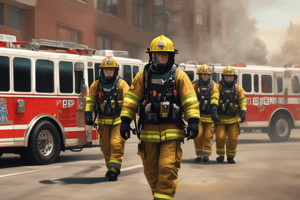Podcast
Questions and Answers
What is the main advantage of the meeting method of training?
What is the main advantage of the meeting method of training?
- It allows participants to choose topics freely.
- The leader can control the topics discussed. (correct)
- It fosters informal discussions.
- It encourages individual presentations.
Which motivation factor is recognized as the highest influence on people's behavior in a training context?
Which motivation factor is recognized as the highest influence on people's behavior in a training context?
- Achievement (correct)
- Company Policies
- Work Environment
- Promotion
Which statement is NOT true regarding cost-benefit analysis for training programs?
Which statement is NOT true regarding cost-benefit analysis for training programs?
- The benefits must exceed the costs.
- The costs can be estimated with accuracy.
- Improved morale can result from training.
- Lowering accident-related costs is a typical benefit. (correct)
What defines a performance-based training program?
What defines a performance-based training program?
Which of the following best describes a case study in training?
Which of the following best describes a case study in training?
What does the acronym LAN stand for in computer-based safety training?
What does the acronym LAN stand for in computer-based safety training?
Which statement is true regarding the effectiveness of safety training presentations?
Which statement is true regarding the effectiveness of safety training presentations?
What is NOT an advantage of using questionnaires for needs assessment?
What is NOT an advantage of using questionnaires for needs assessment?
Which of the following methods is commonly NOT used for conducting a needs assessment?
Which of the following methods is commonly NOT used for conducting a needs assessment?
Which of the following is considered an advantage of interviewing subject matter experts for needs assessment?
Which of the following is considered an advantage of interviewing subject matter experts for needs assessment?
What is the first step in developing a safety training program?
What is the first step in developing a safety training program?
What is the first step in the development of a safety training program?
What is the first step in the development of a safety training program?
In identifying a safety training program, what does 'validity' refer to?
In identifying a safety training program, what does 'validity' refer to?
Which statement accurately describes a learning curve?
Which statement accurately describes a learning curve?
Which of the following is NOT a characteristic of role-playing training technique?
Which of the following is NOT a characteristic of role-playing training technique?
Which statement is NOT true regarding the meeting or conference method of training?
Which statement is NOT true regarding the meeting or conference method of training?
What is the purpose of defining objectives in a safety training program?
What is the purpose of defining objectives in a safety training program?
What is the value of brainstorming in role-playing training techniques?
What is the value of brainstorming in role-playing training techniques?
Why is it essential to limit the number of participants in meetings for training?
Why is it essential to limit the number of participants in meetings for training?
Which step is NOT part of ensuring that learning activities succeed for trainees?
Which step is NOT part of ensuring that learning activities succeed for trainees?
Which characteristic is NOT typically considered to affect learning in the trainee population?
Which characteristic is NOT typically considered to affect learning in the trainee population?
What is the primary basis for safety training objectives?
What is the primary basis for safety training objectives?
Which statement about conducting a safety training program is true?
Which statement about conducting a safety training program is true?
Which of the following is NOT a guideline experienced instructors typically follow?
Which of the following is NOT a guideline experienced instructors typically follow?
In what order should steps be taken to ensure trainees master the objectives?
In what order should steps be taken to ensure trainees master the objectives?
Which of the following is considered a critical need during safety training?
Which of the following is considered a critical need during safety training?
What type of characteristics may affect the learning of trainees?
What type of characteristics may affect the learning of trainees?
Which of the following statements about the safety training program evaluation is true?
Which of the following statements about the safety training program evaluation is true?
Which option is essential for making training effective?
Which option is essential for making training effective?
Which of the following is NOT one of the three domains of learning?
Which of the following is NOT one of the three domains of learning?
Which statement regarding safety training is NOT true?
Which statement regarding safety training is NOT true?
Which step is NOT involved in developing learning activities for safety training?
Which step is NOT involved in developing learning activities for safety training?
Which option is NOT considered a red flag for the need for a safety training program?
Which option is NOT considered a red flag for the need for a safety training program?
Which of the following is NOT a component of measurable objectives in safety training?
Which of the following is NOT a component of measurable objectives in safety training?
Which of the following action verbs is considered measurable in a performance statement?
Which of the following action verbs is considered measurable in a performance statement?
Which of the following is NOT an example of measurable performance?
Which of the following is NOT an example of measurable performance?
Which aspect is critical for effective safety training programs?
Which aspect is critical for effective safety training programs?
Which of the following statements is true regarding safety training motivation?
Which of the following statements is true regarding safety training motivation?
Which factor is an essential part of developing a safety training program?
Which factor is an essential part of developing a safety training program?
Flashcards
What is the first step in developing a safety training program?
What is the first step in developing a safety training program?
The initial step in designing a safety training program involves clearly defining its specific goals and objectives.
What is 'validity' in a safety training program?
What is 'validity' in a safety training program?
Validity in a safety training program refers to ensuring that its content and activities cover all essential aspects of safety for the specific tasks being addressed. It means that the program directly addresses the hazards and required skills for safe performance of those tasks.
Describe the relationship between learning and time.
Describe the relationship between learning and time.
A learning curve demonstrates that while skill improvement increases with time and effort, it eventually reaches a plateau. Initial gains are rapid, but the rate of improvement slows down as learners approach mastery.
What is role-playing training used for?
What is role-playing training used for?
Signup and view all the flashcards
Why is the meeting or conference method effective for training?
Why is the meeting or conference method effective for training?
Signup and view all the flashcards
What's crucial for effective meeting or conference training?
What's crucial for effective meeting or conference training?
Signup and view all the flashcards
Meeting Method Training
Meeting Method Training
Signup and view all the flashcards
Achievement Motivation
Achievement Motivation
Signup and view all the flashcards
Cost-Benefit Analysis
Cost-Benefit Analysis
Signup and view all the flashcards
Performance-Based Training
Performance-Based Training
Signup and view all the flashcards
Case Study
Case Study
Signup and view all the flashcards
LAN
LAN
Signup and view all the flashcards
Cost-Benefit Analysis (True Statement)
Cost-Benefit Analysis (True Statement)
Signup and view all the flashcards
Training Benefits (True Statement)
Training Benefits (True Statement)
Signup and view all the flashcards
Performance-Based Training (true statement)
Performance-Based Training (true statement)
Signup and view all the flashcards
Case Studies (True Statement)
Case Studies (True Statement)
Signup and view all the flashcards
Uniform Hazardous Waste Manifest
Uniform Hazardous Waste Manifest
Signup and view all the flashcards
Job Hazard Analysis (JHA)
Job Hazard Analysis (JHA)
Signup and view all the flashcards
Safety Training Objectives
Safety Training Objectives
Signup and view all the flashcards
Effective Safety Training
Effective Safety Training
Signup and view all the flashcards
Trainee Characteristics
Trainee Characteristics
Signup and view all the flashcards
Pilot Safety Training Program
Pilot Safety Training Program
Signup and view all the flashcards
Active Learning Techniques
Active Learning Techniques
Signup and view all the flashcards
Tailoring Safety Training
Tailoring Safety Training
Signup and view all the flashcards
Avoid Unreasonable Fears
Avoid Unreasonable Fears
Signup and view all the flashcards
Structure Safety Training
Structure Safety Training
Signup and view all the flashcards
Keep safety training engaging.
Keep safety training engaging.
Signup and view all the flashcards
What is a needs assessment in safety training?
What is a needs assessment in safety training?
Signup and view all the flashcards
What is the advantage of using questionnaires in a needs assessment?
What is the advantage of using questionnaires in a needs assessment?
Signup and view all the flashcards
What is 'disequilibrium' in learning?
What is 'disequilibrium' in learning?
Signup and view all the flashcards
Why can expert interviews be biased?
Why can expert interviews be biased?
Signup and view all the flashcards
What are the three domains of learning?
What are the three domains of learning?
Signup and view all the flashcards
How does motivation impact safety training effectiveness?
How does motivation impact safety training effectiveness?
Signup and view all the flashcards
Does safety training always improve employee morale?
Does safety training always improve employee morale?
Signup and view all the flashcards
Why is the cost of safety training often underestimated?
Why is the cost of safety training often underestimated?
Signup and view all the flashcards
Why is it important to consider the learning characteristics of trainees?
Why is it important to consider the learning characteristics of trainees?
Signup and view all the flashcards
How do course evaluation materials relate to developing learning activities?
How do course evaluation materials relate to developing learning activities?
Signup and view all the flashcards
What role do instructional materials play in developing learning activities?
What role do instructional materials play in developing learning activities?
Signup and view all the flashcards
What are red flags for the need of safety training?
What are red flags for the need of safety training?
Signup and view all the flashcards
Why are measurable goals and objectives important in safety training?
Why are measurable goals and objectives important in safety training?
Signup and view all the flashcards
What is a "performance" statement in a safety training objective?
What is a "performance" statement in a safety training objective?
Signup and view all the flashcards
Study Notes
Safety Training Program Development
- The first step in developing a safety training program is defining the objectives.
- Identifying employees needing training is crucial.
- Training materials should be easily understandable and appropriate to the subject of training.
- Qualified instructors are essential.
- Validity in safety training programs ensures coverage of all relevant legal requirements and risk reduction areas.
- Identifying hazards, knowledge, and skill requirements for safe performance is part of validity.
- A learning curve shows proficiency gained directly proportional to time spent, eventually reaching a limit.
- Role-playing training techniques involve members participating to solve problems, brainstorming for solutions to specific problems, and changing personnel issues.
- Effective meetings allow each member to contribute knowledge, limiting the number of participants for productive discussions and recording the ideas.
- The highest motivation factor for training is achievement.
- Cost-benefit analysis of training programs focuses on the benefits exceeding the costs.
- Performance-based training focuses on a specific job problem.
- Feedback from workers and supervisors during evaluations affects final training programs.
- Case studies are valuable for demonstrating how people or organizations have dealt with certain issues.
- Training can be delivered to many workstations using LANs (Local Area Networks).
- There are three domains of learning: cognitive, affective, and psychomotor. Safety training is effective when trainees are motivated.
- Effective safety training maintains employee morale, and training costs are often easier to overlook than equipment costs.
- Key training elements include identifying trainee characteristics, writing/selecting course materials and training needs.
Needs Assessment
- The needs assessment identifies the need for a training program.
- Observation of employee performance, questionnaires, and interviews with subject matter experts are methods for assessment.
- Advantages of questionnaires include the quantity of data collected and summarization capabilities, however, possible low response rates can be a disadvantage.
- Interviewing experts can reveal training details but is sometimes time-consuming.
- Safety training materials should be presented in a way that helps trainees understand and learn; the instructor's effectiveness is important, and helping the trainees develop an understanding of the materials can improve the training's effectiveness.
Studying That Suits You
Use AI to generate personalized quizzes and flashcards to suit your learning preferences.




